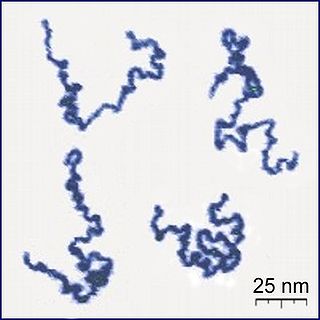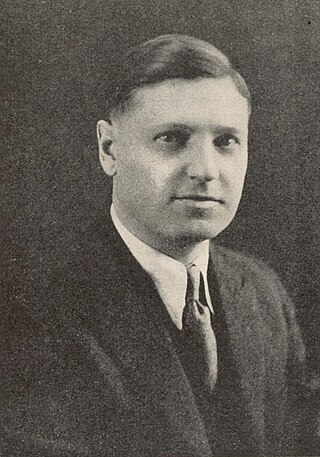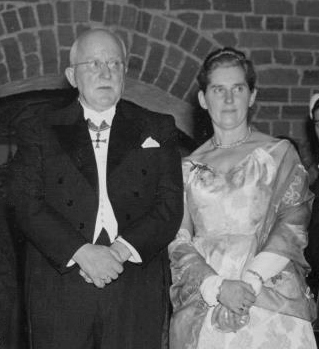
A polymer is a substance or material consisting of very large molecules called macromolecules, composed of many repeating subunits. Due to their broad spectrum of properties, both synthetic and natural polymers play essential and ubiquitous roles in everyday life. Polymers range from familiar synthetic plastics such as polystyrene to natural biopolymers such as DNA and proteins that are fundamental to biological structure and function. Polymers, both natural and synthetic, are created via polymerization of many small molecules, known as monomers. Their consequently large molecular mass, relative to small molecule compounds, produces unique physical properties including toughness, high elasticity, viscoelasticity, and a tendency to form amorphous and semicrystalline structures rather than crystals.

A macromolecule is a very large molecule important to biological processes, such as a protein or nucleic acid. It is composed of thousands of covalently bonded atoms. Many macromolecules are polymers of smaller molecules called monomers. The most common macromolecules in biochemistry are biopolymers and large non-polymeric molecules such as lipids, nanogels and macrocycles. Synthetic fibers and experimental materials such as carbon nanotubes are also examples of macromolecules.

Karl Waldemar Ziegler was a German chemist who won the Nobel Prize in Chemistry in 1963, with Giulio Natta, for work on polymers. The Nobel Committee recognized his "excellent work on organometallic compounds [which]...led to new polymerization reactions and ... paved the way for new and highly useful industrial processes". He is also known for his work involving free-radicals, many-membered rings, and organometallic compounds, as well as the development of Ziegler–Natta catalyst. One of many awards Ziegler received was the Werner von Siemens Ring in 1960 jointly with Otto Bayer and Walter Reppe, for expanding the scientific knowledge of and the technical development of new synthetic materials.

Soft matter or soft condensed matter is a subfield of condensed matter comprising a variety of physical systems that are deformed or structurally altered by thermal or mechanical stress of the magnitude of thermal fluctuations. These materials share an important common feature in that predominant physical behaviors occur at an energy scale comparable with room temperature thermal energy, and that entropy is considered the dominant factor. At these temperatures, quantum aspects are generally unimportant. Soft materials include liquids, colloids, polymers, foams, gels, granular materials, liquid crystals, flesh, and a number of biomaterials. When soft materials interact favorably with surfaces, they become squashed without an external compressive force. Pierre-Gilles de Gennes, who has been called the "founding father of soft matter," received the Nobel Prize in Physics in 1991 for discovering that methods developed for studying order phenomena in simple systems can be generalized to the more complex cases found in soft matter, in particular, to the behaviors of liquid crystals and polymers.
Polymer chemistry is a sub-discipline of chemistry that focuses on the structures of chemicals, chemical synthesis, and chemical and physical properties of polymers and macromolecules. The principles and methods used within polymer chemistry are also applicable through a wide range of other chemistry sub-disciplines like organic chemistry, analytical chemistry, and physical chemistry. Many materials have polymeric structures, from fully inorganic metals and ceramics to DNA and other biological molecules. However, polymer chemistry is typically related to synthetic and organic compositions. Synthetic polymers are ubiquitous in commercial materials and products in everyday use, such as plastics, and rubbers, and are major components of composite materials. Polymer chemistry can also be included in the broader fields of polymer science or even nanotechnology, both of which can be described as encompassing polymer physics and polymer engineering.

Hermann Staudinger was a German organic chemist who demonstrated the existence of macromolecules, which he characterized as polymers. For this work he received the 1953 Nobel Prize in Chemistry.

The National Historic Chemical Landmarks program was launched by the American Chemical Society in 1992 to recognize significant achievements in the history of chemistry and related professions. The program celebrates the centrality of chemistry. The designation of such generative achievements in the history of chemistry demonstrates how chemists have benefited society by fulfilling the ACS vision: Improving people's lives through the transforming power of chemistry. The program occasionally designates International Historic Chemical Landmarks to commemorate "chemists and chemistry from around the world that have had a major impact in the United States".

This timeline of chemistry lists important works, discoveries, ideas, inventions, and experiments that significantly changed humanity's understanding of the modern science known as chemistry, defined as the scientific study of the composition of matter and of its interactions.

Herman Francis Mark was an Austrian-American chemist regarded for his contributions to the development of polymer science. Mark's X-ray diffraction work on the molecular structure of fibers provided important evidence for the macromolecular theory of polymer structure. Together with Houwink he formulated an equation, now called the Mark–Houwink or Mark–Houwink–Sakurada equation, describing the dependence of the intrinsic viscosity of a polymer on its relative molecular mass. He was a long-time faculty at Polytechnic Institute of Brooklyn. In 1946, he established the Journal of Polymer Science.
Carl Shipp "Speed" Marvel was an American chemist who specialized in polymer chemistry. He made important contributions to U.S. synthetic rubber program during World War II, and later worked at developing polybenzimidazoles, temperature-resistant polymers that are used in the aerospace industry, in fire-fighting equipment, and as a replacement for asbestos. He has been described as "one of the world's outstanding organic chemists" and received numerous awards, including the 1956 Priestley Medal and the 1986 National Medal of Science, presented by President Ronald Reagan.
The plastics industry manufactures polymer materials—commonly called plastics—and offers services in plastics important to a range of industries, including packaging, building and construction, electronics, aerospace, manufacturing and transportation.

Macromolecular Chemistry and Physics is a biweekly peer-reviewed scientific journal covering polymer science. It publishes full papers, talents, trends, and highlights in all areas of polymer science, from chemistry to physical chemistry, physics, and materials science.

Egbert (Bert) Willem Meijer is a Dutch organic chemist, known for his work in the fields of supramolecular chemistry, materials chemistry and polymer chemistry. Meijer, who is distinguished professor of Molecular Sciences at Eindhoven University of Technology (TU/e) and Academy Professor of the Royal Netherlands Academy of Arts and Sciences, is considered one of the founders of the field of supramolecular polymer chemistry. Meijer is a prolific author, sought-after academic lecturer and recipient of multiple awards in the fields of organic and polymer chemistry.

Elmer Otto Kraemer was an American chemist whose studies and published results materially aided in the transformation of colloid chemistry from a qualitative to a quantitative science. For eleven years, from 1927 to 1938, he was the leader of research chemists studying fundamental and industrial colloid chemistry problems and a peer of Wallace Hume Carothers at the Experimental Station of the E. I. du Pont de Nemours Company where both men contributed to the invention of nylon that was publicly announced on October 27, 1938. The 1953 Nobel Laureate in chemistry, Hermann Staudinger, had a high regard for the American pioneers in polymer chemistry, particularly Kraemer and Carothers

Plastics are a wide range of synthetic or semi-synthetic materials that use polymers as a main ingredient. Their plasticity makes it possible for plastics to be moulded, extruded or pressed into solid objects of various shapes. This adaptability, plus a wide range of other properties, such as being lightweight, durable, flexible, and inexpensive to produce, has led to its widespread use. Plastics typically are made through human industrial systems. Most modern plastics are derived from fossil fuel-based chemicals like natural gas or petroleum; however, recent industrial methods use variants made from renewable materials, such as corn or cotton derivatives.

Institut Charles Sadron is a research center of the Centre national de la recherche scientifique, associated with the University of Strasbourg, which was created in 1954 to answer the demand for fundamental research in the emerging field of polymer science.
John Douglass Ferry was a Canadian-born American chemist and biochemist noted for development of surgical products from blood plasma and for studies of the chemistry of large molecules. Along with Williams and Landel, Ferry co-authored the work on time-temperature superposition in which the now famous WLF equation first appeared. The National Academy of Sciences called Ferry "a towering figure in polymer science". The University of Wisconsin said that he was "undoubtedly the most widely recognized research pioneer in the study of motional dynamics in macromolecular systems by viscoelastic techniques".

The Charles Goodyear Medal is the highest honor conferred by the American Chemical Society, Rubber Division. Established in 1941, the award is named after Charles Goodyear, the discoverer of vulcanization, and consists of a gold medal, a framed certificate and prize money. The medal honors individuals for "outstanding invention, innovation, or development which has resulted in a significant change or contribution to the nature of the rubber industry". Awardees give a lecture at an ACS Rubber Division meeting, and publish a review of their work in the society's scientific journal Rubber Chemistry and Technology.

This is a list of women chemists. It should include those who have been important to the development or practice of chemistry. Their research or application has made significant contributions in the area of basic or applied chemistry.

Magda Staudinger was a Latvian biologist and botanist who studied macromolecules with her husband Hermann Staudinger and their application to biology. She was acknowledged as his collaborator when he won the Nobel Prize for Chemistry, and she published seven volumes of his works after his death. She was awarded the Grand Order of the Latvian Academy of Sciences Medal for her contributions to the furtherance of science.
















